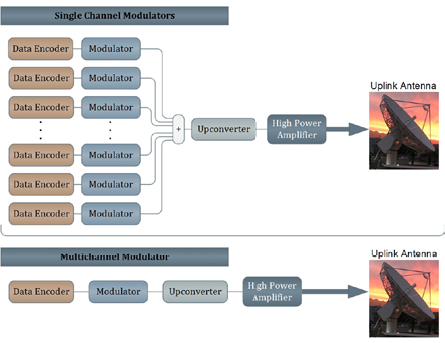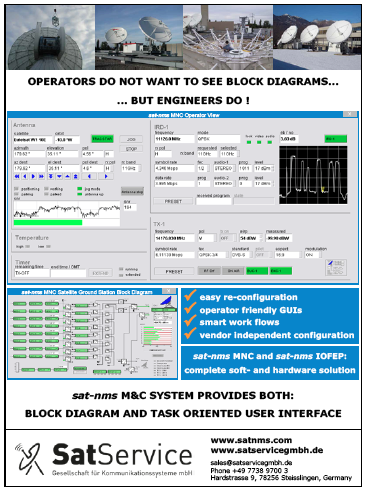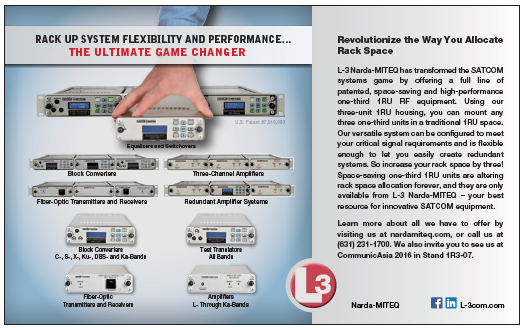Single channel modulators have well served the satellite marketplace over the last decades.

Modulators perform an integral function in broadcast applications such as direct-to-home (DTH) services, as well as point-to-point data services like cellular backhaul and content distribution. The modulator performs the 24x7 mission-critical operations of ingesting the input data stream bits, in the form of IP or MPEG packets, and then transforming the data into a radio-frequency (RF) waveform for transmission to the satellite.
Other industries like the cable TV and other terrestrial markets formerly used single channel modulators for their services, albeit using different RF transmission standards and data formats. Over the last few years, these industries have completely transitioned to multichannel modulators to replace single channel modulators.
The primary reason for the transition is that multichannel modulators have comparable signal fidelity and quality but provide significant cost savings in terms of capital expenditures and long-term operating expenses. As technology has evolved, the satellite industry can now benefit from a similar movement towards multichannel satellite modulators.
How Is A Modulator Used In An Uplink Facility?
The modulator is positioned in the uplink chain after the data generating equipment like video playout or multiplexing devices or data encapsulators, as depicted in the figure below. For most new equipment purchases, customers are moving to IP based equipment rather than the ASI connections found on previous generation modulators. The IP-centric approach allows the data to be generated anywhere in the customer’s network and distributed through standard networking equipment to the uplink facility.
The modulator transforms the data into the waveform required by the uplink and typically uses the DVB-S2 standard or the more recently introduced DVB-S2X (extensions) standard to maximize the efficiency of the satellite transponder or channel with regards the number of bits/Hz transmitted.
The waveform is upconverted by a frequency translator to Ku-or Ka-band for transmission to the satellite. The high frequency signal is then amplified by a TWTA or SSPA prior to uplink by the station antenna. For a wideband system with many channels, the output of several single channel modulators is combined to form an aggregate signal for upconversion and amplification.
Because the data being uplinked by the gateway or teleport is mission critical, redundancy (not shown in the simplified figure) is incorporated into the uplink chain to ensure that equipment failures do not interrupt the signal transmission. Many service providers also incorporate site diversity because signal fade due to highly variable weather conditions, particularly at Ka-band and higher frequencies, can interrupt the uplink signal.
As mentioned, availability is a critical aspect of the transmission system. Unlike the original one uplink chain for one channel architecture that was common in the early days of broadcast, more and more items in the uplink chain handle multiple channels in a single device.
Data playout sources aggregate many channels and multi-cast this data to the rest of the transmission chain. Wideband amplifiers and frequency converters handle many channels. The multichannel modulator continues this trend. When combined with a suitable redundancy switch, the multichannel modulator can be used in the uplink chain while maintaining five nines of availability.
The Advantages
In the uplink architecture, replacing the multichannel modulator to replace multiple single channel modulators is possible as well as advantageous. The primary reason for the selection of the multichannel modulator is to reduce cost. Initial capital expenditures and ongoing operating expenses can be reduced by using multichannel modulators in place of single channel modulators.
With the current technology available in the market, one multichannel modulator can replace as many as 16 traditional modulators. This corresponds to a significant reduction in rack space populating the equipment room where space is often at a premium.

Most modulators are 1 rack unit (RU) high—they realize a 16 to 1 reduction in rack space required for the multichannel modulator. The savings in rack space is even more dramatic when modulator redundancy is considered. Often, modulators are used in a 1:1 or 1:8 redundancy configuration where one single channel modulator is available as a hot spare for each modulator (1:1) or for a bank of 8 modulators (1:8).
For a 64 modulator configuration using 1:1 redundancy, four equipment rack cabinets can be replaced by 8 multichannel modulators that only take up one-quarter of a single rack cabinet. The extra rack and floor space can be used for other customer equipment or can reduce the amount of space leased from a third-party building provider. The wiring for one modulator instead of 16 units is also greatly simplified. The number of cables is also reduced for RF wiring and for network cables.
The initial capital expenditure to procure multichannel modulators is much lower when 8 multichannel modulators are purchased instead of 128 single channel modulators. Although the components used within the multichannel modulator are more technologically advanced and likely to be more expensive than the single channel units, savings can be realized from the reduction of similar components within the modulator like the power supplies and chassis. This leads to an overall lower price per channel in terms of procurement.
Some vendors even offer licensing schemes that enable a smaller number of channels to be purchased originally within the modulator and additional software licenses added later to unlock additional channels as the customer’s requirements expand.
Along with the capital expenditure savings and the reduction in space required for the modulators in the equipment room, there are also other important savings in operating expenses—electricity and HVAC costs. A multichannel modulator draws roughly the same amount of power as a single channel modulator.
Due to the reduction in the number of modulators required, power bill savings of thousands of dollars per year can be achieved. The reduction in power consumption also leads to reduced cooling costs in the equipment room—HVAC cost reduction is similar to the power consumption cost reduction. The reduced need for cooling allows smaller air conditioning units to be used for the building, which reduces the original build-out cost of an equipment room. The reduced power consumption and HVAC costs save money annually and are also good for the environment.
Suitable Applications
Many applications are suitable for the inclusion of a multichannel modulator. A new uplink site build-out is but one example. For a new facility under construction, the savings in initial purchase price coupled with the reduced equipment room size and ongoing operational savings lead to an attractive business case when compared to the single channel modulator architecture.
Another suitable application is a diversity site build-out, which is becoming more important as climate change is causing modified weather patterns. Existing uplink facilities are experiencing more rain fade outages, which are triggering the need for backup facilities to be put into place to handle these outages. The diversity site advantages are similar to a new uplink site build out and also provide a way for an operator to become familiar with and comfortable with the multichannel technology prior to use in the main facility.

Most service providers are unlikely to replace their existing single channel modulators while they are still operating because the infrastructure is already in place. However, as the facilities age and failures with the modulators start to occur, and the inventory of spare modulators is exhausted, multichannel modulators are an attractive alternative as a replacement for the single channel modulators. Depending on the uplink architecture, the multichannel modulator can be a drop-in replacement for several single channel modulators and start taking over for the aging single channel modulators as they fail.
The multichannel modulator also has advantages for transmissions of 4K or Ultra High Definition (UHD) video. These emerging applications over satellite require high bandwidths to be transmitted over the satellite and can benefit from the channel bonding features available in the DVB-S2X standards.
Multichannel modulators are uniquely suitable for UHD because the delay between the bonded channels can be tightly controlled in the transmission from a single source. Single channel modulators cannot achieve the same level of synchronization and they can cause higher levels of skew between channels. This, in turn, can complicate set top box (STB) design.
The multichannel modulator is also uniquely able to bond together portions of a transponder and make use of underutilized bandwidth on a transponder to generate additional revenue from a satellite transponder.
The S2X channel bonding can be used in conjunction with the multichannel modulator to enable this new application and remove the need for the satellite operator to move around customer bandwidth as leases expire in order to tightly pack together customer bandwidth.
In this application, the multichannel modulator, along with a complementary multichannel receiver, provide a way for this fragmented bandwidth to be consolidated into a usable virtually contiguous bandwidth that can more readily be commercialized with minimal impact to operations.
Now Is The Time Of The Multichannel Modulator
The advantages of the multichannel modulator are clear for broadcast and point-to-point applications. The initial capital savings and ongoing operational savings are significant. The new technology is a viable fit for new uplink site build-out, diversity sites, aging facility refurbishment, new applications based on channel bonding such as UHD/4K video, and increasing bandwidth efficiency on existing transponders.
SED is a leader in multichannel technology and the company’s multichannel modulator, Hercules, is available in the satellite marketplace. Hercules provides as many as 16 independently configurable and controllable channels and can be sized to meet the needs of the transmission facility.
A companion product, the smart monitoring and redundancy switch Itus complements Hercules and provides a highly available and reliable modulator solution. The compelling advantages of this impressive technology make a strong case that multichannel technology is ready for broad-based adoption. The time for the multichannel modulator has now arrived.
Peter Waskowic, P. Eng., M.Sc., is the Business Manager of SATCOM Products at SED Systems, a division of Calian Ltd. Peter has worked in the satellite industry for more than 20 years.




